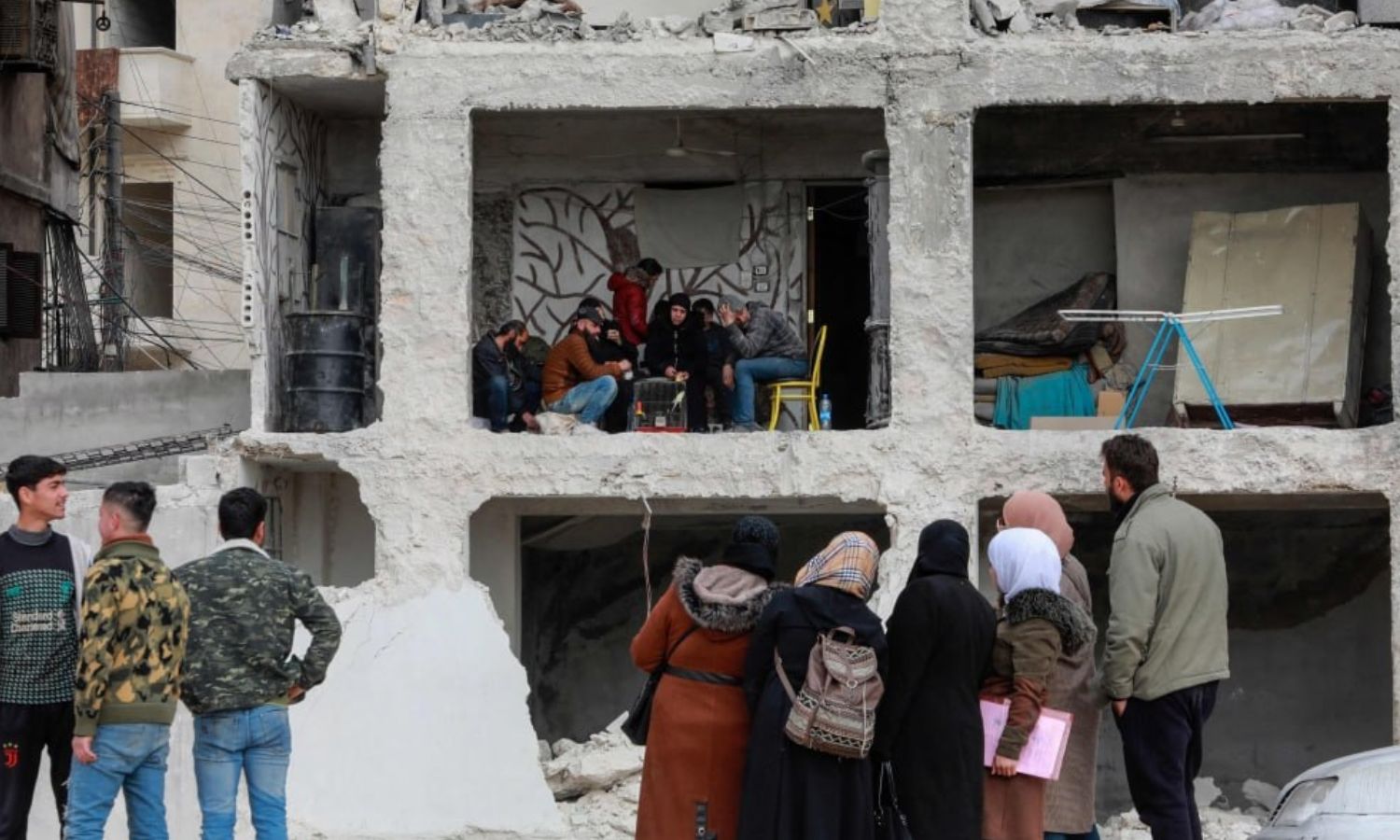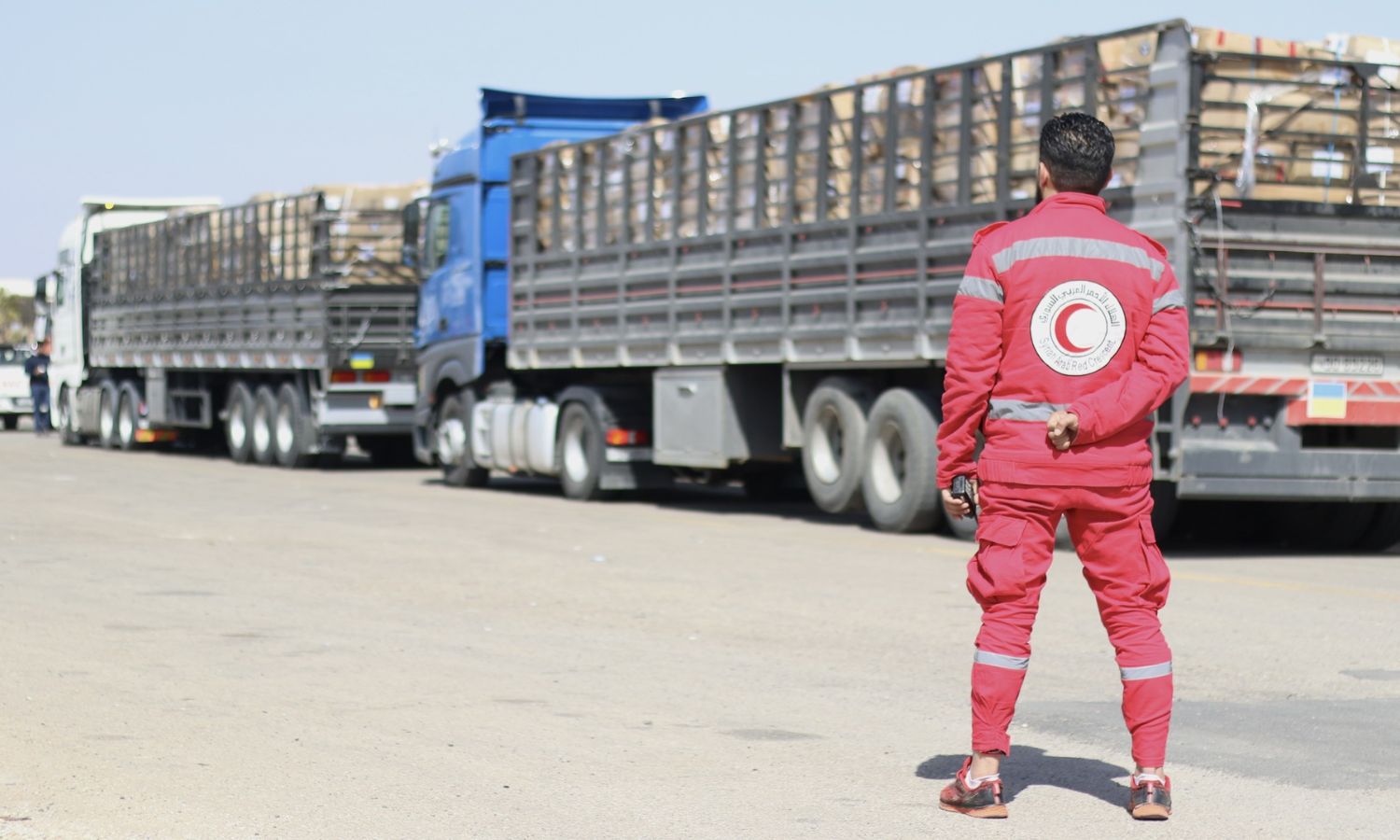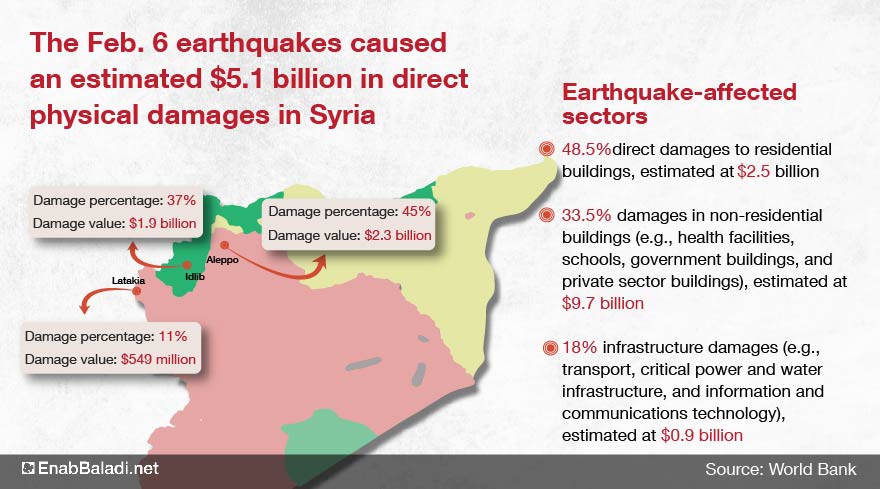Jana al-Issa | Lujain Mourad
A full month has passed since the devastating February 6 earthquake that hit northern Syria and southern Turkey, and the Syrian regime still has not clearly announced an action plan to compensate those affected in its areas of control.
Rather, the regime met the disaster with vague promises, despite the pledge of many international organizations and countries to provide financial and in-kind assistance for the benefit of those affected.
The movements of regime officials during last February centered around talking about the current response in terms of securing temporary shelters without including a clear plan of action with a timetable for rebuilding what was destroyed by the Turkey-Syria earthquake that killed at least 50,000 people, including about 6,000 in Syria, according to the United Nations figures.
On the other hand, there have been movements of officials in areas not directly affected by the earthquake as well, through the formation of expanded engineering committees with the aim of exposing the cracked buildings as a result of the earthquake, most notably in the governorates of Damascus, its suburbs and Homs.
These areas were subjected to devastating bombardment during the years of war, which has prevented some of its residents from returning to their homes until now.
The areas in which the engineering committees concentrated their activities were affected by the earthquake to a limited extent, compared to the affected northwestern governorates, namely Aleppo, Latakia, and Hama, as well as Idlib and the northern countryside of Aleppo that are outside the control of the regime.
In light of the quake-related reconstruction, Syrian officials see the disaster as an opportunity to amend the real estate specifications of the affected areas and organize the unregulated ones without a clear reference to the working mechanism.
On February 20, the regime’s Minister of Public Works and Housing stated that there are quick and new decisions related to urban planning and work on laws and legislation to facilitate work “exceptionally,” without further clarifications about that.
Amidst the hazy solutions, the Syrian regime has utilized the earthquake disaster for its benefit at various levels, benefiting from the funds flowing for the earthquake-affected areas. All have raised inquiries about the possibility of the regime exploiting these funds in implementing its plan to rebuild areas in accordance with its interests, areas it may not have been hit by the earthquake.
Destruction caused by earthquake or bombing?
“Earthquake Map” kept secret in govt drawers
The Syrian regime has not issued a detailed report on the neighborhoods completely affected by the earthquake in the governorates of Aleppo, Latakia, and Hama, even though a month has passed since the disaster.
According to the latest statistics issued by the government of the regime, the number of buildings that collapsed directly in the affected governorates at the moment of the earthquake reached 199 residential buildings, without knowing until now the extent of the destruction of industrial facilities, factories, and other workshops.
From the first day, the regime’s government began to form technical committees for engineering inspection in the governorates hit by the earthquake to assess the condition of the buildings that were partially damaged, as a result of which it was decided to demolish 292 buildings that were about to fall.
According to a report issued by the Higher Relief Committee headed by the Minister of Local Administration and Environment, Hussein Makhlouf, on March 2, the most recent report on the results of the detection reached 4,444 unsafe and unreinforced buildings, while the number of buildings that needed to be strengthened to become safe reached 29,751 buildings, and the number of safe buildings that need maintenance was 30,113 buildings.
The report did not mention the precise locations of these buildings in the affected governorates, while separate media reports stated that the earthquake caused double the destruction in the neighborhoods of al-Shaar, Sad al-Lawz, Qadi Askar, al-Masharqa, al-Salihin, al-Maysar, and other neighborhoods located in the eastern part of the city of Aleppo, which is one of the most destroyed neighborhoods as a result of the war in the region.

The Civil Defense rescue teams during search operations in response to the earthquake disaster in Hama governorate – February 6, 2023 (AP)
Opportunity to “organize”
The lack of transparency in identifying the neighborhoods actually affected by the earthquake has opened the door to questions about the possibility of the regime exploiting the disaster to demolish buildings that may not have been damaged by the earthquake with the aim of using aid funds to organize slums within new executive urban plans or to expand plans that are already being worked on.
The Minister of Public Works and Housing, Suhail Abdul-Latif, stated during a press conference about the existence of new legislation to regulate matters related to the earthquake, as it does not exist in Syrian law.
Abdul-Latif said that there are “plans that the government is preparing, and there will be new decisions and legislation that help mitigate the effects of the earthquake, which is being studied by all ministries and competent authorities,” without elaborating on additional details about the plans.
Regarding the organization of the buildings damaged by the earthquake, Abdul- Latif said, “We have a national map for housing, and it includes (Prevent and Allow) zones, as the prohibition zones include any expansion or establishment of any new organizational schemes in it, and no new scheme can be allowed to be established without the approval of (Regional Planning Commission) as the competent authority for that.
He added that the authority was assigned to do so, and there may be an amendment to the map of prevention and permits, meaning that after studying earthquake sites by specialists, this map may be modified, and some buildings that were present may not be allowed to be erected, “but logically speaking, if these houses are within the zoning plans, these buildings will be restored again.”
In this context, the Aleppo City Council is studying with the Ministry of Local Administration to treat the situation of slums in the governorate by demolishing and investing in the earthquake disaster in rebuilding them again, according to what the head of the Engineers Syndicate in the city of Aleppo, Hani Barhoum, said.
Demolition and evacuation outside earthquake zones
Most of the provincial councils under the control of the Syrian regime in areas far from the areas affected by the earthquake have formed special engineering committees to inspect the buildings and make decisions to evacuate them to determine whether they are suitable for restoration or if they should be demolished. A step that came hours after the earthquake that struck four Syrian governorates.
The government of the regime decided, relying on the engineering inspection committees, to evacuate a number of buildings in the governorates of Homs, Damascus, and the countryside of Damascus because of their cracks as a result of the war on the one hand, and for being “affected” by the earthquake on the other hand, according to the justifications of the provincial councils, and this is a toll that has increased periodically since the earthquake.
The Damascus governorate has so far evacuated two buildings in the Mazzeh 86 district as a result of damage to a structural element in one building, provided that it takes its decision to demolish or restore it when the report of the specialized committee is issued.
The Homs governorate also evacuated 27 families from several buildings within the neighborhoods of al-Qusour, al-Qarabees, Jouret al-Shayah, al-Khalidiyah, and al-Bayada.
In Rif Dimashq (Damascus Suburbs) governorate, the Public Safety Committees monitored 27 cracked buildings in the city of Harasta and removed five of them completely, while parts of the rest of the buildings will be removed to be renovated. They also evacuated three cracked buildings in the Adra al-Omaliyah suburb and three buildings in the city of Douma, because of their cracking as a result of the war and the negative impact of the earthquake on it, according to the committees’ statements.
The governorate demolished six ramshackle and uninhabitable buildings in the schools area in the town of al-Hameh, and three additional buildings are scheduled to be demolished in the area.
Will the regime exploit aid for reconstruction?
The previous indicators showed the regime’s readiness to exploit the disaster and implement the plans it aspires to in the file of reconstruction outside the areas affected by the earthquake amid the absence of transparency and the demolition of buildings within areas destroyed by the war, which may not have actually been affected by the earthquake, in addition to government statements regarding the possibility of establishing or expanding urban development schemes in slum areas to take advantage of the earthquake.
Many countries opened the doors of support and aid to the Syrian regime a few hours after the earthquake disaster, expressing their willingness to provide “humanitarian” support.
UAE aid emerged at the forefront of the support allocated to Syria, as it provided financial support in the amount of 20 million dirhams (more than $5 million) for the implementation of the Ramadan program in Syria, preceded by the arrival of hundreds of planes loaded with relief materials, and announcements of allocating funding to Syria and Turkey.
The European Union has also allocated 3.5 million euros in funding for those affected in all Syrian regions after receiving a request from Damascus in this regard, in addition to the US announcing the allocation of 85 million dollars as urgent humanitarian aid for the victims of the earthquake in Syria and Turkey.
The United States, Britain, and the European Union issued a six-month sanctions exemption for all transactions related to providing disaster relief to Syria after earthquakes to facilitate humanitarian aid for those affected by the earthquake, which raised fears that they would be exploited by the regime to implement reconstruction projects for areas not destroyed by the earthquake, in light of its officials’ focus on the importance of these projects within the disaster response plans.
Mohammad al-Abdallah, Executive Director at Syria Justice and Accountability Centre (SJAC), said in a video recording on the center’s Facebook page that Western sanctions do not prevent the delivery of aid to those affected by the earthquake in Syria, but “the devil is in the details.”
The Syrian human rights defender divided the types of aid that may be sent to Syria into in-kind, on which sanctions have no effect, based on the in-kind aid that arrived from the first day from many countries to the airports under the control of the regime.
As for the other section, which is financial aid, it is exempted when the goal of its spending is humanitarian.
In an interview with Enab Baladi, al-Abdallah ruled out that the regime could use the earthquake assistance to carry out reconstruction projects, noting that the sanctions prohibiting the implementation of such projects are still in place.
Al-Abdallah added that any assistance sent outside the framework of the response to the earthquake disaster towards reconstruction would trigger a Western reaction to obstruct it.
Western exceptions to sanctions against the Syrian regime in response to the earthquake disaster in February 2023:
1- On February 9, the United States issued a six-month sanctions exemption for all transactions related to providing disaster relief to Syria.
The license includes bank transfers through government banks to serve the earthquake relief efforts so that people working to provide relief to those affected by the earthquake can focus on their efforts, according to the US Treasury.
2- The latest authorizations came from the European Union, on February 23, by issuing an amendment that allows humanitarian organizations to transfer or provide goods and services intended for humanitarian purposes to Syrian persons and entities on the EU sanctions lists without the need for prior permission from the competent national authorities in the member states.
The EU justified this step by facilitating the rapid delivery of humanitarian aid to Syria, given the seriousness of the humanitarian crisis, which was exacerbated by the earthquake.
3- Britain said on February 15 that it was issuing two new licenses to make it easier for aid agencies helping earthquake relief efforts to operate in Syria without breaching sanctions aimed at the Syrian regime and its backers, according to Reuters.
The British government said the temporary new licenses would “strengthen the timely and effective delivery of relief efforts by removing the need for individual license applications.”
“UK sanctions do not target humanitarian aid, food, or medical supplies, but we recognize that the current requirements for individual licensing are not always practical during a crisis response,” Minister of State for International Development Andrew Mitchell said in a statement.
The licenses provide broad protection to organizations to allow them to operate by authorizing activities that would have otherwise been prohibited, Reuters reported.
Exploitation margins are limited
Concerns are raised about the existence of margins and loopholes that allow the Syrian regime to benefit from in order to serve its interests, especially in the reconstruction file, despite the identification of Western exceptions from the sanctions imposed on the regime with humanitarian aid intended for the response to the earthquake.
This is due to the “great” experience documented by press and international investigations and reports about the regime’s ability to circumvent sanctions.
This was accompanied by a refusal by US officials who criticized Washington’s decision to ease the sanctions, as the Chairman of the US House of Representatives Foreign Affairs Committee, Michael McCaul, and a member of the Senate Foreign Relations Committee, James Risch, described the easing of sanctions as “a slap in the face of the Syrian people.”
US Representative French Hill also considered it “reckless behavior,” warning that it contributes to “filling the pockets of the Syrian regime.”
The first researcher in the Syrian Legal Development Programme, Iyad Hamid, told Enab Baladi that the licenses of the recent Western sanctions are limited to the humanitarian response and the provision of food and medical materials, stressing that it is not a total lifting of the sanctions imposed on the Syrian regime.
He added that these exceptions are time-bound and do not give enough time to start the reconstruction process in the style that the regime wants.
Al-Abdallah, the Syrian human rights defender, believes that the licenses granted to the Syrian regime have limited impact and are unable to provide margins of exploitation that meet the regime’s desire for reconstruction.
In a move to prevent the Syrian regime from benefiting from the licenses, The US House of Representatives passed a resolution on February 28, mourning the loss of life in the earthquakes that hit Turkey and Syria and condemning Syria’s Bashar al-Assad regime for blocking UN aid through its border, according to the Anadolu Agency.
The resolution included a call for a greater oversight mechanism to be used to ensure that US funds are not channeled to the Syrian regime.
|
The licenses are clear, but the regime is trying to exploit the catastrophe for a comprehensive lifting of sanctions, and this will not happen. Mohammad al-Abdallah, Executive Director at Syria Justice and Accountability Center |
On the other hand, the exceptions were not satisfactory to the Syrian regime, as the Syrian Foreign Ministry said, in its comment on the US exemptions, that “the decision is misleading, and provides for a partial and temporary freeze of some unilateral and lethal coercive measures imposed on the Syrian people.”
An analytical study of sanctions authorizations issued by the Syrian Ministry of Foreign Affairs considered that the US administration’s decision to make an exception confirms that these sanctions represent an obstacle to the delivery of aid to Syria.
Money is scarce, theft is a priority
Countries announced pledges to provide sums of money to Syria and Turkey in response to the earthquake disaster amid talk about the regime’s continued theft of aid and manipulation of its distribution mechanism.
Activist al-Abdallah said that the sums granted to the regime would not be sufficient for “theft” and the implementation of reconstruction projects.
According to United Nations estimates, the cost of reconstruction is about $442 billion, while the funds granted to the regime will not exceed a few million.
Al-Abdallah considered that the regime could exaggerate the estimates of losses from the earthquake to earn more money, but the limited amount of damage caused by the earthquake impedes that.
There are no official statistics on the earthquake’s losses, while Syrian academics estimated the losses at $44.535 billion, according to what was published by the government Tishreen newspaper.
However, these numbers are contradicted by impartial data.
The World Bank said on March 4 that Syria sustained an estimated $5.1 billion in damages in last month’s massive earthquake.
The World Bank estimates of the total direct damages in Syria using the replacement costs of what was damaged by the earthquake range between $2.7 and 7.9 billion.
|
Corruption is rampant, and even in-kind aid did not escape being stolen, and this is enough to reduce any concern about the regime exploiting the disaster for reconstruction. Mohammad al-Abdallah, Executive Director at Syria Justice and Accountability Center |
Iyad Hamid of the Syria Legal Development Programme believes that the regime will try to divert aid from the most needy victims and direct it to serve its interests.
However, the nature of the international response will not reach the scale of the reconstruction process as desired by the Syrian regime.
According to Hamid, the aid provided is limited to relief and early recovery projects, and its size will not meet the needs of the regime areas even in the context of the humanitarian response to the earthquake disaster, indicating that it is unlikely that the regime will benefit from it to implement reconstruction projects.
During the past years, dozens of reports showed the Syrian regime’s manipulation of aid, as a report issued by the Center for Strategic and International Studies in Washington (CSIS) revealed that the perpetrators of violations in Syria are at the forefront of the beneficiaries of humanitarian aid.
The report notes that the Syrian regime’s manipulation of aid is “unique and continuous” and has grown in the past decade of war, which requires a comprehensive audit and evaluation of aid in Syria.
What reconstruction does Assad want?
Regime officials’ talk about the existence of proposals for the reconstruction of destroyed areas under the pretext of the earthquake raises questions about the regime’s vision for reconstruction in Syria, as it is always looking for gains to achieve rather than rebuilding what it destroyed during the past years.
Dr. Karam Shaar, Director of the Syrian Program at the Observatory of Political and Economic Networks, believes that reconstruction is a top priority for the regime, as it constitutes a political and economical way out of its current crises.
Shaar told Enab Baladi that the highest aspiration of the regime today is for the private sector to participate in the reconstruction process without the risk of being subjected to Western sanctions.
While the researcher in political economy and local administration at the Omran Center for Strategic Studies, Ayman al-Dassouky, does not believe that the regime is currently concerned with reconstruction in order to overcome the disasters of the conflict or directing it to rebuild the state and society to achieve stability and sustainable peace.
Instead, the regime is far more interested in ending its international political isolation.
The revenues the regime may obtain from abroad help it face the economic and service entitlements in the areas under its control and make use of it later to embark on a reconstruction phase if possible, according to the researcher.
Al-Dassouky told Enab Baladi that reconstruction from the perspective of the regime is currently represented as a tool for reshaping the economy and society in a selective manner in a way that guarantees it greater influence and more stability for its regime in the long term.
This makes many countries “not enthusiastic about this approach due to the corruption and control they face,” he added.
For his part, researcher Iyad Hamid believes that the reconstruction, as produced by the decisions of the Syrian regime, is based initially on displacing residents from neighborhoods that it considered “incubators for the popular movement” against it.
He added that the aim of the desire to rebuild these areas and the reorganization decisions is certainly not to return the affected people to their homes but to create investment projects for luxury apartments funded by a private sector controlled by businessmen close to the regime and benefiting from the war economy.
The prices of the few new apartments that have been announced for completion in the executive plans that are being worked on in Marota City and Basilia City projects, for example, indicate that they are beyond the ability of the majority of Syrians to purchase.
In addition to imposing the condition of obtaining security approval to rebuild any of the damaged buildings in other neighborhoods, which confirms the regime’s desire to control who can return or live in these areas, according to Hamid.

Bashar al-Assad, head of the Syrian regime, during his visit to the affected areas in northern Aleppo city on the fifth day of the earthquake – February 10, 2023 (AP)
Quake-affected people at risk of losing property
In April 2018, the head of the Syrian regime, Bashar al-Assad, issued Law No. 10, whose articles caused an unprecedented uproar, and occupied space in the local and international media.
The law has been criticized for the time of its promulgation since it was issued at a time when more than half of the Syrians fled their homes, according to UN statistics. This means that the government may take their absence and loss of ownership papers as a pretext to lay claim to their property through what they consider as “legal” ways.
A zoning plan is issued with the aim of developing and reconstructing one of the areas qualified for that, whether it is a new area, an expansion of a previous plan, or a re-planning of an area that was destroyed for any reason whatsoever.
The zoning plan defines the needs of a region in terms of housing, administrative and commercial centers, schools, gardens, industrial and craft areas, and necessary services required for the development of the country within 25 years.
Most of the urban zoning plans issued by the government of the regime do not take into account the rights of residents who do not own title deeds to their real estate, which threatens to erode their real estate rights.
The regime’s behavior causes a lack of interest in returning real estate rights to their owners by creating real estate legal disputes that accumulate over time, which is considered a threat to the social, economic, and legal stability in Syria’s post-conflict future.
Ghazwan Kronfol, head of the Free Syrian Lawyers Association, told Enab Baladi that, in principle, “we must realize that not every regulatory process for an urban area is necessarily part of a scheme aimed at controlling the residents’ property and demographically reshaping society, but certainly every area previously destroyed by bombing is subject to this.
Kronfol clarified that this might apply to the areas of eastern Aleppo recently affected by the earthquake, while it may not necessarily apply to areas affected by the earthquake, such as the cities of Jableh and Latakia.
Regarding the follow-up of human rights organizations working on the real estate property file in Syria, the issue of the future benefit of the Syrian regime from the earthquake disaster, and its exploitation in the file of reconstruction or the implementation of executive plans for urban areas under Law No. 10, Kronfol says that the issue of the reconstruction of any area cannot take place in secret and does not need monitoring mechanisms.
“If it occurs, it will be known to the areas covered and its funding sources,” Kronfol added.
The head of the Free Syrian Lawyers Association assured that those who will be most affected by such reconstruction operations are the residents of slums and the residents of unorganized urban areas, such as eastern Aleppo.
On March 5, 2018, the former Minister of Public Works and Housing in the government of the regime, Hussein Arnous, issued Decision No. 791 to issue an amendment to the general master plan for the city of Aleppo.
Arnous indicated at the time that the new zoning plan would be the first building block in the city’s reconstruction process, and several amendments followed, the latest of which was in April 2022.
The head of the Aleppo Governorate Council, during the period of opposition control, Yahya Nanaa, warned that the new urban development plan would contribute to the regime’s control of the property of the residents of the eastern neighborhoods of the city because most of them were forcibly displaced to the northwestern Idlib region.
At the time, Nanaa indicated that many residents would not be able to prove their ownership of their real estate within the one-year period specified in the objection according to most of the urban planning laws.
Nanaa indicated that the largest part of the unlicensed residential buildings is located in the eastern neighborhoods of Aleppo and that the largest proportions of destruction are concentrated in its slums, which were subjected to intense bombardment between 2013 and 2016.
According to the World Bank, Syria’s northern province of Aleppo was the most severely quake-hit region, accounting for 45% of the total damages in Syria and amounting to about $2.3 billion in damages.
Aleppo was followed by the northwestern province of Idlib, with estimated damages of $1.9 billion, and Latakia, a government-controlled territory on the coast, with $549 million.
if you think the article contain wrong information or you have additional details Send Correction
النسخة العربية من المقال
-
Follow us :













 Survivors of the Syrian earthquake take shelter in destroyed houses in northern Aleppo city - February 22, 2023 (AFP)
Survivors of the Syrian earthquake take shelter in destroyed houses in northern Aleppo city - February 22, 2023 (AFP)





 A
A
A
A
A
A











 More In-Depth
More In-Depth